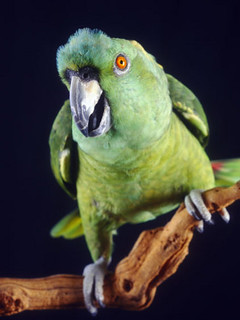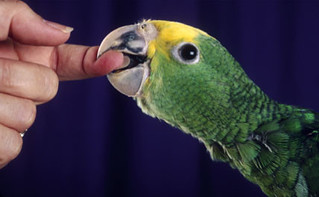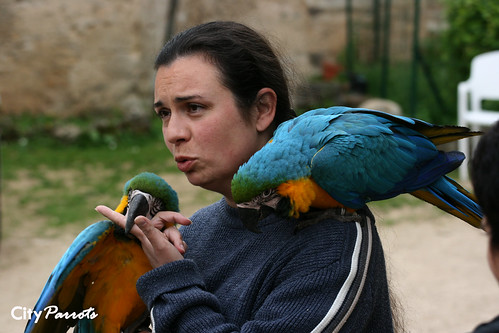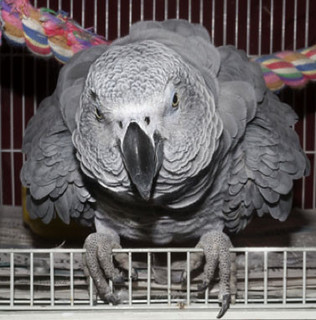To prevent any possible bite, we will want to use something that he can grab with that beak of his and will make biting impossible since his beak is otherwise occupied. In behavior analysis work this is called DRI. Differential Reinforcement with an Incompatible Behavior. Learn about positive reinforcement from Dr. Friedman’s Learning and Living with Parrots class. That was a hint…
 Yellow-naped amazon whose body language is showing pinned eyes, flared tail and wings slightly out... meaning stay away or I will bite you. Credit: Bonnie JayNext is the gorgeous yellow-naped amazon. This amazon is not approachable… don’t even think about it. The eyes are pinned, wings up a little, forehead feathers up, the tail is fanned and the feet are in a wide stance. For the most part amazons let you know when they are willing to bite... and this one is definitely ready.
Yellow-naped amazon whose body language is showing pinned eyes, flared tail and wings slightly out... meaning stay away or I will bite you. Credit: Bonnie JayNext is the gorgeous yellow-naped amazon. This amazon is not approachable… don’t even think about it. The eyes are pinned, wings up a little, forehead feathers up, the tail is fanned and the feet are in a wide stance. For the most part amazons let you know when they are willing to bite... and this one is definitely ready.
Mattie the Moluccan. We can never know what a bird is thinking (even though we think we do) and we describe their thoughts with labels that are likely to have nothing to do with what they are actually thinking. And we will never know of course. We cannot know, but let's analyze this bird's body language and say that this moluccan cockatoo is very surprised and a bit fearful. Feathers are up and away from the body, crest is slightly elevated and wings and mouth are being held open. Based on experience, research and observation, it’s a pretty accurate intrepretation.
 Moluccan cockatoo. Body language of leaning back, mouth slightly open indicates fear and surprise, feathers and wings up say do not pick up or touch. Credit: Bonnie JayThis is a bird that we don’t want to try to pick up. He/she is in a focused moment and is possibly defensive. We just want to keep our fingers to ourselves until things calm down, by the perceived threat being removed from close proximity. If this expression is the result of introducing a new toy, then introduce it more slowly and from farther away and keep your hands to yourself until the bird's body language says it’s ready for something closer.
Moluccan cockatoo. Body language of leaning back, mouth slightly open indicates fear and surprise, feathers and wings up say do not pick up or touch. Credit: Bonnie JayThis is a bird that we don’t want to try to pick up. He/she is in a focused moment and is possibly defensive. We just want to keep our fingers to ourselves until things calm down, by the perceived threat being removed from close proximity. If this expression is the result of introducing a new toy, then introduce it more slowly and from farther away and keep your hands to yourself until the bird's body language says it’s ready for something closer.
Do you know what that might look like? Maybe leaning toward the initially offending object, looking at it, or trying to reach for it or not leaning back, raising feathers or wings when it's moved closer. Each bird is different and their expression of interest will be different.
Here with our beautiful Hawk-headed parrot we can see the same sort of thing. Feathers up, crest up, tail fanned, wings held away from the body, feet far apart in a stable stance. This is a common fear/surprise reaction in almost all birds, and when you see it, keep your body parts to yourself.
 Hawk-headed parrot whose body language shows crest up, flared tail (even thought you cannot see it), wings up and leaning clearly says stay away. Credit: Bonnie JayThere are other forms of fear biting, one being displacement biting. That is when a bird bites something (like the person holding it) because he/she cannot bite the object it wants to bite. If the object that is objected to is near enough, the bitor will leap with glee onto the bitee whenever possible and bite the nearest flesh… hard. If you see signs of puffed feathers and pinned eyes while holding a bird, turn away from the offending object or person promptly.
Hawk-headed parrot whose body language shows crest up, flared tail (even thought you cannot see it), wings up and leaning clearly says stay away. Credit: Bonnie JayThere are other forms of fear biting, one being displacement biting. That is when a bird bites something (like the person holding it) because he/she cannot bite the object it wants to bite. If the object that is objected to is near enough, the bitor will leap with glee onto the bitee whenever possible and bite the nearest flesh… hard. If you see signs of puffed feathers and pinned eyes while holding a bird, turn away from the offending object or person promptly.
Also, unless you really, really know your bird, never hand off your bird, or any other bird to another person, because it’s a good way for you to get bitten. Most birds do not appreciate being handed off, especially not to just anyone, even if they ‘look’ like they want to step off. Some birds are just fine with it, so once again learn about your bird’s body language. The preferred method of having a bird move from one person to another is by placing it on a perch and having the other person offer their hand or arm and carefully observe whether a foot is lifted for a step up or if the bird is leaning back so far it's about to fall off the perch. Do not insist.
Here’s another comment from Dr. Friedman: “To prevent biting 1) give the bird an acceptable alternative way to communicate 'no' by backing away when the bird does that behavior, and 2) teach the bird that approaching you results in great outcomes for the bird so it chooses to draw you in. Shaping birds to step onto hands by reinforcing small approximations works great because done well, it results in a high rate of reinforcement.” By the way, pinned eyes can also mean excitement or joy. They aren’t a given for a bite, but you need to know the difference.
 Yellow-crowned parrot juvenile showing exploratory biting, it is simply exploring it's world and the finger in front of it. Credit: Bonnie JayThis Yellow-crowned parrot is exhibiting exploratory biting. The bird takes a chomp of whatever it is, often a finger, to feel and test it for biteability perhaps. It's not agression based. But it’s different from nibbling. Nibbling feels good and is soft and gentle. A bite is a bite is a bite and does not feel good, especially if it pierces our tender flesh and bleeds as we yell while making haste toward the bathroom for a band aid. Nibbling isn’t like that at all. Nibbling is lovely.
Yellow-crowned parrot juvenile showing exploratory biting, it is simply exploring it's world and the finger in front of it. Credit: Bonnie JayThis Yellow-crowned parrot is exhibiting exploratory biting. The bird takes a chomp of whatever it is, often a finger, to feel and test it for biteability perhaps. It's not agression based. But it’s different from nibbling. Nibbling feels good and is soft and gentle. A bite is a bite is a bite and does not feel good, especially if it pierces our tender flesh and bleeds as we yell while making haste toward the bathroom for a band aid. Nibbling isn’t like that at all. Nibbling is lovely.
Mattie Moonbeam, a tiny moluccan cockatoo (pronounced mo-luck-an) is very territorial as are many birds, especially large cockatoos. There is not actually an image of her biting because it’s not the sort of thing one plans for and there are no volunteers. But there is territorial biting and it generally means that the bird is protecting it’s perceived territory from you the perceived intruder.
Mattie is saying something like, “Hi, this is my floor and you’re feet are on it. I’m in charge here and I make all the rules, so just in case you’re inclined to doubt that, I will give you a painful bite on your toe just to prove it. Then watch me run back to a safe place where I can shout and scream about how I 'gotcha'!” It’s an imaginative translation of course, but it’s very close. One cannot know what she’s thinking, but we can see her body language and that speaks volumes.
We also know that when Mattie tilts her head to the side and looks at her victim with that twinkle in her eye (Can you see the twinkle in the side bar?), she is also waiting for just the right moment to bite the victim’s ankle if they are outside the apartment, or their toes if they are inside. Her timing is impeccable and that look of innocence is never to be trusted in these circumstances because it’s only a lure for the victim to relax.
She does it by being all cute and harmless looking, sweet and alluring, then bam! she bites the nearest flesh and shrieks in joy on the hysterical run back to her cage, only to climb it with her feathers and crest all raised, rocking side to side in joy. When strangers come to visit, Mattie is now placed into her cage with lots of positive reinforcement and enrichment for the duration of the visit.
Outside her home she will go to everyone and gently cuddle against them. It’s just in her home she is dangerous to strangers. Many birds are territorial. Remember, you want to design the environment for success… always! Now, in Mattie's home there are no bites, no blood and no yelling.
To avoid this type of bite, keep your feet off the floor and your fingers out of cages. Just make sure your host or hostess has their bird who is known to be a territorial biter, in a cage or another room before you walk into the bird’s territory.
Respect and honor your birds, love them to bits, feed them the best organic food and mash you can, give them as much out of the cage time as possible, tons of enrichment and learn their body language. Observe them. This will give you the greatest opportunity to prevent biting and caregive a healthy, happy, cherished bird in a long, loving relationship.
May compassion prevail.

